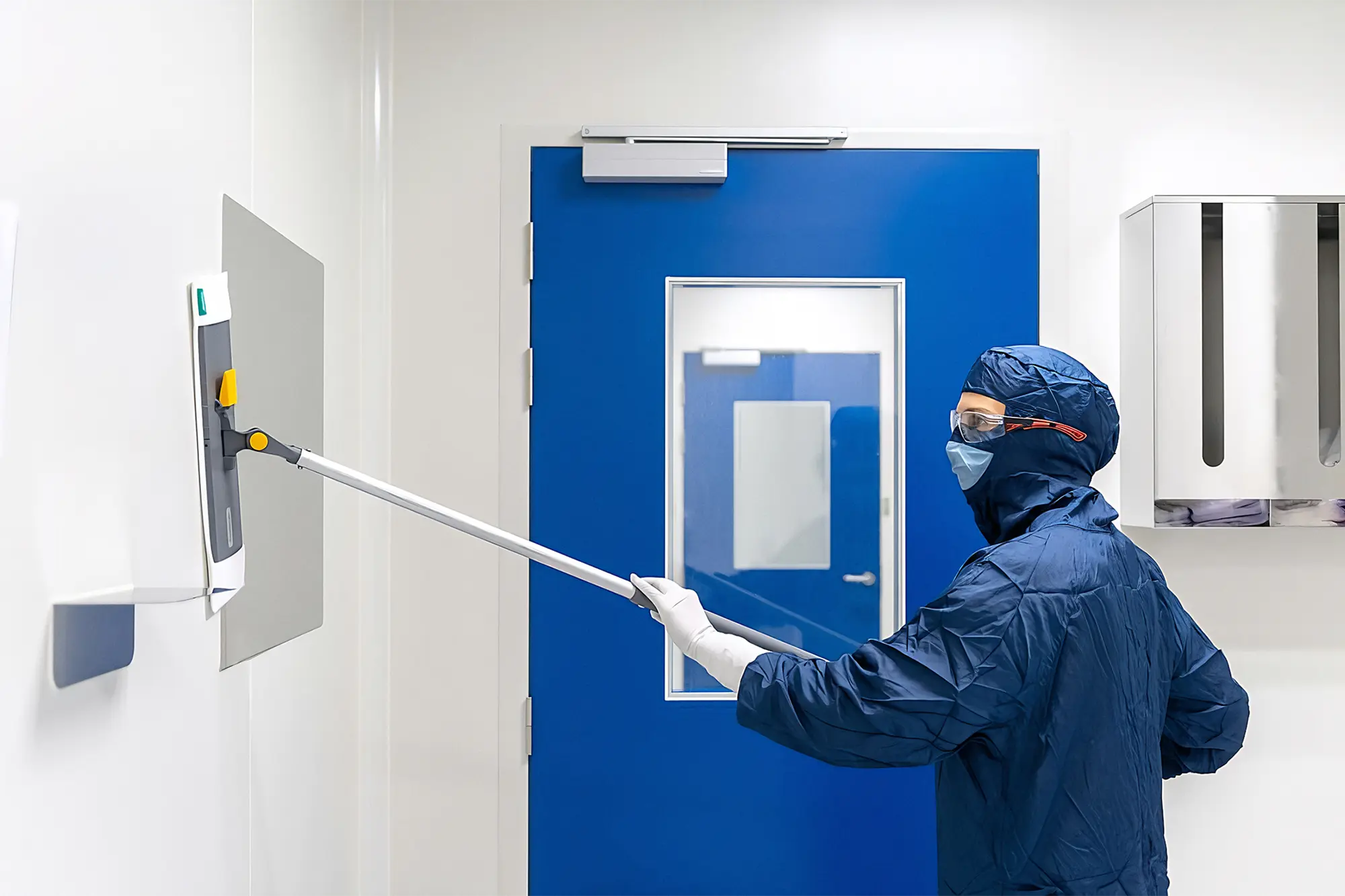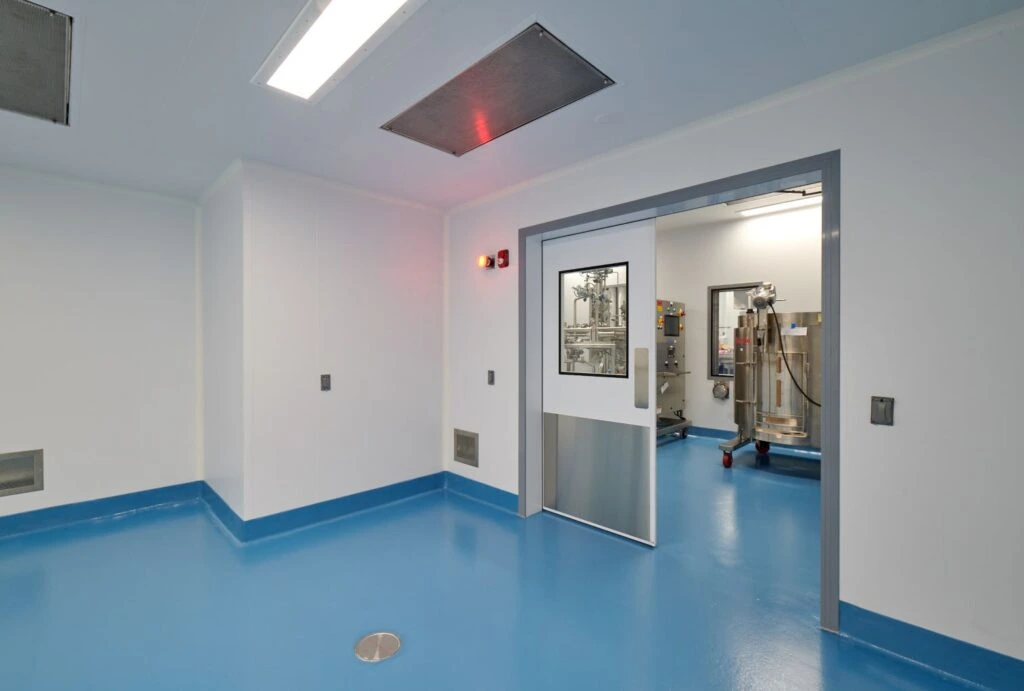How to Clean Your Cleanroom
Discover cleanroom cleaning best practices, frequencies, and ISO standards. Explore VHP & UV light tech for sterilization and contamination control.

Maintaining a Pristine Environment: How to Clean Your Cleanroom
Maintaining a pristine environment is paramount in scientific research, semiconductor manufacturing, and additional, highly regulated industries. Enter the cleanroom: a controlled space meticulously engineered to minimize airborne particles and contaminants. But how do we keep these critical spaces sparkling clean? This blog will offer a contemporary perspective on the tasks supporting cleanroom cleaning and explore best practices, frequencies, and regulations.
The Art: How are Cleanrooms Cleaned?
Cleaning a cleanroom follows a choreography, prioritizing top-down and non-shedding techniques. Start from the ceiling, diligently removing dust and particles with HEPA-filtered vacuums. Walls and windows receive the same treatment, ensuring no microscopic hitchhikers linger. Work surfaces and equipment undergo a meticulous wipe-down using lint-free cloths and specialized cleaning solutions. Minimizing shedding is crucial, as stray fibers can become unwelcome guests. Finally, floors get their turn, tackled with mops soaked in sanitized solutions and dried with HEPA-filtered vacuums. This meticulous approach ensures a truly controlled environment.
Finding the Rhythm: How Often Should Cleanrooms Be Cleaned?
Frequency is key in the cleanroom cleaning world. Just like watering your plants, consistency is crucial. The exact schedule depends on the cleanroom’s classification (think of it as different levels of cleanliness) and activities conducted within. High-classification cleanrooms, used for delicate tasks like microchip fabrication, demand daily cleaning before and after operations. Less sensitive environments require cleaning every other day or even weekly. But remember, these are just baselines. If your activities generate more dust or contaminants, adjust accordingly!
The Code of Cleanliness: What is the ISO for Cleanroom Cleaning?
In the world of cleanrooms, there’s a rulebook, the International Organization for Standardization (ISO) 14644, guiding best practices. It defines different cleanroom classifications based on the maximum allowable number of particles per cubic meter of a specific size. Think of it as a roadmap to achieving and maintaining desired cleanliness levels. While not a legal requirement, adhering to ISO 14644 demonstrates a commitment to quality and control, which can be crucial for regulatory compliance and client assurance.
The Art of Cleanliness: What are the Procedures for Cleaning a Cleanroom?
Beyond generalities, let’s dive into the practicalities. Here’s a glimpse into the procedures governing cleanroom cleaning:
- Gown Up for Success: Before entering the cleanroom, personnel don appropriate protective gear like coveralls, gloves, and booties to minimize contamination introduced from their bodies.
- Preparation is Key: Gather cleaning supplies like HEPA-filtered vacuums, lint-free cloths, and approved cleaning solutions. Ensure they are compatible with your specific cleanroom materials and processes.
- Starting from the Top: Remember our choreography analogy? Begin by cleaning ceilings, walls, and windows, working your way down to minimize particle redistribution.
- Wiping with Precision: Use designated cleaning solutions and lint-free cloths to meticulously wipe down work surfaces and equipment, following established protocols to avoid cross-contamination.
- Floors Get Their Due: Tackle floors last, using mops and HEPA-filtered vacuums with sanitized solutions to ensure a pristine finish.
- Documentation is Crucial: Record cleaning activities, including dates, times, and personnel involved, to maintain a clear audit trail and demonstrate adherence to protocols.
Remember: While these are general guidelines, always consult your specific cleanroom protocols and regulations for the most accurate and up-to-date cleaning procedures.
New Technologies: VHP & UV Light
There are new technologies being adopted and integrated into the design of modern modular cleanrooms. Vaporized hydrogen peroxide (VHP) and UV light have emerged as cutting-edge technologies for the cleaning and sterilization of modular cleanrooms, ushering in a new era of efficiency and reliability. VHP, known for its potent antimicrobial properties, is deployed in a gaseous form, infiltrating every nook and cranny of the cleanroom, effectively eliminating a wide spectrum of pathogens, including bacteria, viruses, and spores. Its non-toxic nature and rapid degradation into harmless byproducts make it environmentally friendly and safe for sensitive equipment.
Complementing VHP, UV light serves as a powerful adjunct, capable of disinfecting surfaces and air by disrupting the DNA structure of microorganisms, rendering them incapable of replication. Together, these technologies provide a comprehensive approach to cleaning and sterilization, ensuring modular cleanrooms maintain the highest standards of hygiene crucial for sensitive industries such as pharmaceuticals, biotechnology, and electronics manufacturing.
Avoiding Mistakes: From People to Processes
Cleanroom managers and personnel can prevent contamination and ensure a consistently pristine environment by understanding common mistakes and implementing proper training, procedures, and documentation.
Personnel-related mistakes:
- Improper gowning: Not adhering to correct gowning procedures, like skipping glove changes or failing to cover hair adequately, can introduce contaminants.
- Lack of training: Untrained personnel might use incorrect techniques or cleaning agents, risking the cleanroom environment.
- Eating, drinking, or applying cosmetics inside the cleanroom can introduce particles and bacteria.
- Rushing or making excessive movements: Quick movements can stir up dust and particles, compromising air quality.
Cleaning procedure mistakes:
- Using non-approved cleaning agents or cloths might shed fibers or react negatively with cleanroom materials, contaminating the environment.
- Skipping the top-down approach: Cleaning floors first can redistribute particles onto already cleaned surfaces.
- Not double-rinsing mops: Contaminated mop water can redeposit dirt on floors.
- Follow designated cleaning patterns to avoid missed areas and uneven cleaning.
- Neglecting equipment and surfaces: Leaving tools or equipment uncleaned can harbor contaminants.
- Improper waste disposal: Contaminated waste must be handled and disposed of according to specific protocols to prevent cross-contamination.
Documentation mistakes:
- Neglecting to document cleaning activities can create gaps in the audit trail and hinder quality control.
- Inaccurate or incomplete documentation: Please provide more accurate information to avoid discrepancies and complicating investigations.
- Failing to review and update documentation: Protocols and regulations evolve, so documentation must keep pace.
Additional mistakes:
- Propping doors open: This disrupts the airflow pattern and allows unfiltered air to enter.
- Using personal electronic devices inside the cleanroom can harbor contaminants and introduce security risks.
- Overusing disinfectants: Excessive use can damage surfaces and create breeding grounds for resistant bacteria.
Using Software to Document Cleaning
Cleanroom cleaning teams may rely on something other than specific software for their day-to-day cleaning tasks. However, various software solutions can help manage and optimize cleanroom cleaning processes. Here’s a breakdown:
Software for Documentation and Record Keeping:
- Electronic Data Management Systems (EDMS): These systems allow for digital storage and management of cleaning records, including dates, times, personnel involved, cleaning agents used, and protocol deviations. Implementing this system ensures easy access, retrieval, and data analysis for audits and quality control purposes.
- Computerized Maintenance Management Systems (CMMS): Unlike EDMS, CMMS can track cleaning schedules, maintenance tasks, and equipment calibration records relevant to cleanroom upkeep. They can also generate reports and send alerts for upcoming tasks, streamlining overall cleaning management.
Conclusion:
Maintaining a cleanroom is a detailed endeavor, demanding dedication and precise techniques. By understanding the “how,” “when,” and “why” of cleanroom cleaning, we can ensure these critical environments remain pristine, paving the way for successful research, manufacturing, and other sensitive activities. Remember, a cleanroom is more than just a space; it’s a testament to precision, control, and the pursuit of excellence.
At CleanSpace, we understand the vital role cleanrooms play in ensuring sensitive research, manufacturing, and other activities are conducted in a contamination-free environment. That’s why we go beyond just building modular cleanrooms; we empower our clients with the knowledge and tools to maintain their pristine spaces. By understanding the intricacies of cleanroom cleaning, from best practices to potential pitfalls, you can ensure your CleanSpace modular cleanroom remains a haven of purity, allowing you to focus on what matters most – achieving groundbreaking results.
Remember, a cleanroom is more than just a structure; it’s a testament to your commitment to quality, control, and excellence. Let CleanSpace be your partner in creating and maintaining that perfect environment where innovation can flourish.




















